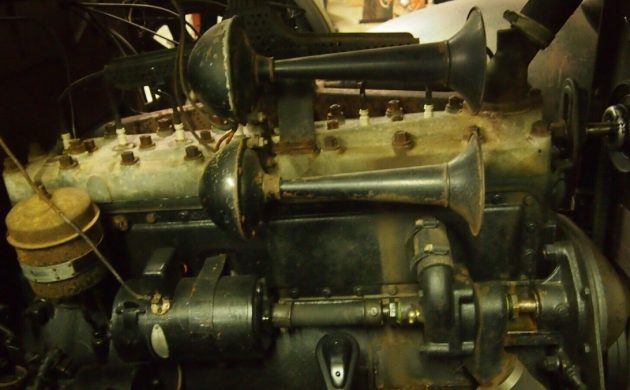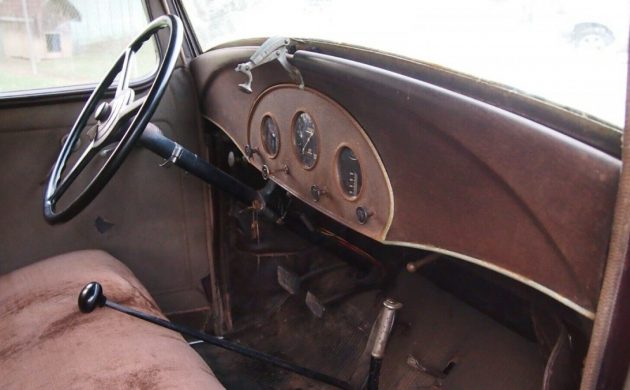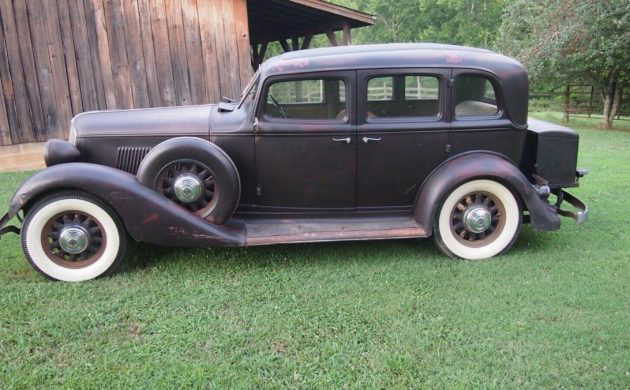Style Leader: 1933 Graham Blue Streak
Even though the paint is looking a bit tired, from certain angles you can still see the sparkle in the paint finish that was one of the innovative hallmarks of the Graham Blue Streak. Today, vehicle manufacturers use fine mica particles to achieve this look. In 1933, Graham achieved this same look by adding finely-ground fish scales to their paint. This 1933 Graham Blue Streak is a solid car that can be driven and enjoyed as it is, or the next owner could choose to undertake a restoration. Located in Heiskell, Tennessee, you will find the Graham listed for sale here on eBay. Bidding has now reached $9,100, but the reserve hasn’t been met.
The owner says that the Graham has no rust issues, and has never suffered any accident damage. It certainly looks straight and clean, and in this shot, you can see some of the sparkle in the paint that I referred to earlier. All of the external trim and chrome appears to be present, and as with the rest of the car, it could be used as it is. If the next owner chooses to undertake a restoration, then the chrome-work will also require some work. The styling of the Graham was certainly distinctive and proved to be something of a trendsetter in 1933. While competitors had largely stuck with fenders that owed a lot of their design to those used on cycles, Graham employed aerodynamic pioneer Amos Northup to give their car a unique appearance. His first innovation was to give the fenders a “faired-in” look. This meant that they not only became what was effectively a picture-frame for the wheels but also hid the dirt and muck that was so easily visible on the inner fenders of competing cars. Northup also sloped the grille back in a bid to achieve aerodynamic improvements, and you only need to sit a Graham next to its competition today to see how effective these two features were.
Powering the Graham is a 245ci straight-8 engine, which sends its power to the rear wheels via a 3-speed manual transmission. The engine produces 90hp, but its greatest strength is the significant amount of torque that it provides. It has a very long stroke, and the addition of dual valve springs and an aluminum cylinder head for the 1933 model year meant that a Graham could pull easily in very high gears from low in the engine’s rev range. The owner says that the engine in the Graham runs well, and doesn’t blow any smoke. He also states that the transmission shifts smoothly and that the 4-wheel hydraulic brakes are very effective.
The interior of the Graham is certainly serviceable as it is, and there is no real need for the next owner to undertake a restoration at this point. The owner states that the interior trim is original, and while I would tend to agree with him to a large extent, I do believe that the seats have received new covers at some point. One thing about the Graham is that there is plenty of interior space, and the car should certainly seat five people in relative comfort.
For someone who is searching for something a bit different in a classic car from the 1930s, this Graham Blue Streak might be just the vehicle. While the Blue Streak was available as a sedan, a coupe, and a convertible, the company only managed to sell a total of 13,000 cars during 1933. To a large extent, this was due to the impact of the Great Depression. However, Graham was still able to get promotional mileage out of the 1933 model in subsequent years. As more manufacturers adopted some of the design ideas from 1933, Graham developed a new advertising slogan: “America’s Most Imitated Car.” Imitation is the sincerest form of flattery, but here is your chance to own the original.
Auctions Ending Soon
 2006 Ford Mustang Saleen S281 SCBid Now5 hours$16,000
2006 Ford Mustang Saleen S281 SCBid Now5 hours$16,000
 2002 Subaru Impreza WRXBid Now3 days$333
2002 Subaru Impreza WRXBid Now3 days$333
 1975 Chevrolet Corvette ConvertibleBid Now3 days$3,000
1975 Chevrolet Corvette ConvertibleBid Now3 days$3,000
 1964 Ford F-100 Camper CustomBid Now3 days$2,000
1964 Ford F-100 Camper CustomBid Now3 days$2,000
 2006 Jeep Wrangler SportBid Now5 days$10,500
2006 Jeep Wrangler SportBid Now5 days$10,500






Comments
Absolutely love this car. Orphan, check. Gorgeous, check. American made, check. Not bid to stupid level, amazing. Prejudice, a little. 1933 was the lowest sales time during the depression in Wisconsin Mine was only the 8th sold in the whole state.Best of all it isn’t a Lancia or Porsche. Thank you BF, for returning the site to our roots.
Grahams are neat.
This one is in great shape.
It should be bid up quite high.
A magnificent machine-I can’t believe that with just 1 day and change left to bid this classy car isn’t up in the fiscal stratosphere!!! Will it be one of those that hits the nutso crazy bidding game at the last hour?
I’m with you, Chuck-I too absolutely love this car. And I’ll bet Rube and gas pump has would agree that though this could be driven as-is, a complete restoration would just be the right thing to do in this case.
Absolutely beautiful car. I have to got to get a garage built real soon.
Dual side mounts always make me smile.
Great looking car, wish I could do something about bringing it home.
bigdoc… Me too. My garage is about the size of this car. Beautiful design work in every area. Would love to see who buys it.
When men designed by hand and a “trunk” was literally a trunk
Outstanding
Very similar lines to a 33 and 34 Ford which I thought we’re the ultimate for the era, but this is much much nicer, IMO.
Is this the same guy as the Cord – grass looks the same…..
It’s green. Must be the same.
If I had this car in my stable of orphan cars, I would do only one thing; Maintain it in this condition, no restoration. This car is fast approaching the century mark in age, and it looks damn good for an original 1933 car. And as many have said here before, it’s only original once.
One stylish car there.
Thank you for spelling Amos Northup’s last name correctly–few people do. An early 1930s Graham is rare. A straight eight Graham is extremely rare! Wow. What’s not to like?
Pete Phillips,
I suspect there are very few people here on Barn Finds who know there is only one letter R in Amos Northup’s name. As I wrote his name, even my spell checker tried to change it to Northrup!
As for a great Graham, The only better example one could possibly find in this condition, is an 8-cylinder open Graham.
I did a restoration of a 1931 Graham Brothers sedan, a 6-cylinder, but it was still a pleasure to drive compared to similar cars in the lower segment of the mid-priced level.
This Graham is a wonderful example of a very small independent manufacturer who, while making the cheaper 6 cylinder cars, was able to produce a quality “upper mid-level priced car” to compete with entry level Packards, Pierce-Arrows, & Chryslers, plus the more common 8-cylinder cars like DeSoto, LaSalle, Buick and Olds.
But by 1933 Graham faced a growing problem. The number of manufacturers making great cars in this price range was about to be reduced and squeezed out by the “Big 3”. in 1932 & 33 a still growing number of the US population could no longer afford such cars, plus those who had bought cars on credit were desperately trying to sell their cars to a population that wasn’t buying.
I save “cars for sale” sections of old newspapers up to about 1980, and what I see is 1931 or ’32 cars that sold for $900 to $1,200 new, being offered for as low as $100, or “Take over payments”. By 1933 Graham was doomed.
Within a couple of short years, basically ALL the small mid-level and upper mid-level manufacturers had stopped making cars like this Graham. Graham was able to stick it out until 1940, staying solvent thanks to military contracts, but after the war they were bought by Kaiser Frazer.
That’s a good read, Bill. Thank you for sharing-more than a few of us wonder about the background of obscure car makers like this and the many others that died or were absorbed by the manufacturing giants of the time, akin to the motorcycles that were built by the various firearm companies then faded away..
What an elegant car but with such a plain Jane dash.
Halftrack,
My first car was an orphan, and even as a young boy I was fascinated by rare & unusual vehicles, hence my interest in the more obscure cars. I’ve even owned cars that a lot of guys here on Barn Finds have never seen, much less heard about. It’s been a desire of mine that unless I was going to a car show sponsored by a specific make or marque, I was determined to show up in a vehicle that was likely to be the only one there.
My parents and their friends always insisted I could tell them the make of almost every car on the streets of Washington, DC, by the time I was 5 years old. Dad tells of what is claimed to be a real story, [but I certainly don’t remember] where as a toddler, I pointed my water bottle at an old car parked at the curb, and I kept saying “Dort, Dort, Dort”. Dad said sure enough, the car was an old Dort sedan! However Dad & Mom also let everyone know that a few months later they realized I was saying I wanted more water, but was calling it dort. [Dort cars were made from 1915 to 1924, in Flint Michigan.]
That’s a cool mantra, Bill, to show up at a car show with something no one else was driving! You’d’ve been in 7th heaven at Bill Harrahs Car Collection in Sparks NV back in the day-row after row, filling to the max floor capacity of a number of railroad warehouses with cars and machinery, all presented with the particulars of that make and model.
It’d be a great gear head get together with you, and too a bunch of the BF readers/editors just to talk unusual transportation stuff and the stories-historical and individuals-that are the heart of the car culture.
Ahhhh, Harrah’s . . . sigh . . . .
In 1978, my longtime friend from Germany, Achim Strauss, another gear head that I still maintain a friendship with today, planned on a special visit to Harrah’s collection, with a personal tour thru ALL the buildings, by Bill H himself.
How did I arrange that? Simple. Harrah was trying to create a 100% complete collection of all Packards, one for each model, going all the way back. I had the only known 1948 22nd series 6-cylinder TAXICAB. Bill Harrah wanted it, but at the time I had said it wasn’t for sale!
Sadly, Bill Harrah suddenly passed away about a week before our arrival. Having been on the road visiting as many states as possible [Maryland to California and back, in a grand circle.] We didn’t know of his passing. When we showed up in Sparks, Nevada and went to the main offices, the young lady who greeted us found out why we were there, and began crying, as she told us the news.
We were given special access badges by the collection’s manager [I think his name was Ralph Dinwoodie or a close variant], and spent 2 days looking at sooooo many vehicles, it was like automotive heaven. I spent an additional $200 on Polaroid film, and used it all up at Harrahs. [That’s like saying I bought about $1,000 in film today.]
Wish I had been able to complete a deal with Harrah, as the Taxi was one of the cars that burned in my big fire 25 years ago.
I still have several big photo albums filled with photos from that visit, as does Achim. The visit to Harrah’s collection was partially to say thanks to my friend for getting me into the private collection in Mulouse France, known as the Schlumpf Collection, where I experienced the art of the European car like never before. That happened after the Schlumpf brothers fled France, and all the cars were covered with white cotton covers. Sadly, no photos were possible on that visit, but we did go back to see it again in 1996, along with the Equally wonderful National French Chemin De Fer Musee [TRAINS!].
It’s always good to join with others who share my passions [don’t ask about my other passions here, after all it’s a public forum! LOL], but because of my age and medical condition, I’m not able to travel very far out of the mid-Atlantic area. You are always welcome to email me, my email is simple, it’s my name [with out the space], at AOL.
My parents told that in my early childhood [early 40s] I always wanted a car with a “roll back lid”, ie: convertible, and I would sit in the back seat of our ’40 Ford and make sounds of cars shifting gears. Cars were loud and dramatic in those days. Since 1964 I have always had at least one convertible and have never owned a car with an automatic transmission..
Bill Mc… Air Force sent us to Fallon, NV in the early ’70s when Harrah’s was in full swing. Over the years we were out there we managed to see everything he collected and more. Tours of the restoration shop, the narrow gauge railroads out in the back lot, the parts building etc. Amazing opportunity that we’ve never forgotten.
bobhess,
If one loves old cars & trucks, I don’t think it is possible to ever forget a visit to the Harrah collection, no matter if it was for days or just an hour or 2.
I have always wondered why, as much as he loved for people to visit the collection, Bill Harrah never made any effort to set it up as a not-for-profit permanent museum, instead running it as just another business enterprise, wholly owned by Holiday Inn, who simply decided to close the whole collection and sell it off upon his death. I’m so glad for the opportunity to see it at it’s finest.
As a collector of rare automobiles, and having had a large parts inventory of rare car parts & accessories, I also had an “in” with the collection’s acquisition department, as I would sell them very hard to find stuff.
Because Harrah loved Packards and other luxury makes, and his staff knew how well I knew the Packard marque’s spare parts, several times I was able to sell them a rather unique selection of spare parts. I would find & buy rough cars,[some in junkyards], like 1950s cars including Packard, Cadillac, Buick, and many lesser marques with factory A/C, and carefully remove EVERY A/C part [down the hardware], making notes and taking photos for reassembly, and offer the A/C sets to the museum. Harrah wanted his cars to have factory A/C whenever possible.
That’s fun. After 20 years in the USAF, I ended up in Tonopah just down the road. Now a USAF contractor out at the Nevada Test and Training Range (NTTR). I bought this Graham and I’m sure she will enjoy the nice dry Nevada air.
Well done, Daniel!!! Congratulations, and have fun with it. Bring it up to Hot August Nights in Reno next year and show it off!!
Congrats!! What are your plans–leave it as is and make it a driver, total restoration, or, heaven forbid, rod it?
So much information here, its an education even for an old car guy. My oldest sister was married to a man named Al Tobel. Al’s parents owned a 1911 (I think) Case Touring care. They owned a motel at Lake Tahoe, Ca and the car sat there for many decades. I don’t know its final destination, but Al always planned to restore, but never did.
God bless America
I bought it. Sweet.
The wood artillery wheels were rare and being phased out at this time. I imagine they were hard to maintain but certainly give cars a brawnier look. I recall seeing a Packard of this vintage with these wheels and they were so distinctive I asked the owned about them. Sure enough he said that were special ordered. The dual vent are also unique.
Is that a reflector on the right rear fender? An accessory? It looks built in. I’ve not seen one like that.
Good luck with this car. Looks very cool.
Wonderful! I believe you picked up a very unique and reliable car, and I hope you do keep it as original as possible, remember, they are only original once.
A bit of advice if I might, You are taking this vehicle from a state that has fairly humid summers, to a state that does not. This car has artillery wood wheel spokes. Watch those spokes very carefully over the next couple years, and I suggest when you get the car home, place it on jack stands, and take the load off the wheel hubs so they can acclimate. Hopefully the wheel to hub specs will remain round.
I [we] look forward to seeing photos of it on the road sometime.